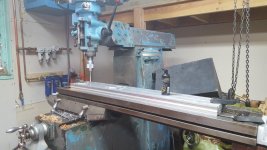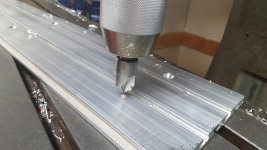This is the worst part of the entire assembly... I measured about 5 times and then completed one piece of table top. I then used 1-2-3 blocks to square up 2 piece UNDER the first completed piece and it worked out just fine.
NOW, this is NOT something I would have wanted to do on a drill press. However, I have a nice mill at my disposal. I know Eddie Cohen managed somehow, but he also said it was a pain. He did the countersinks by hand.... I used the quill stop, so all of them were the same depth.
All told, it was 80 holes that were all countersunk......
NOW, this is NOT something I would have wanted to do on a drill press. However, I have a nice mill at my disposal. I know Eddie Cohen managed somehow, but he also said it was a pain. He did the countersinks by hand.... I used the quill stop, so all of them were the same depth.
All told, it was 80 holes that were all countersunk......

